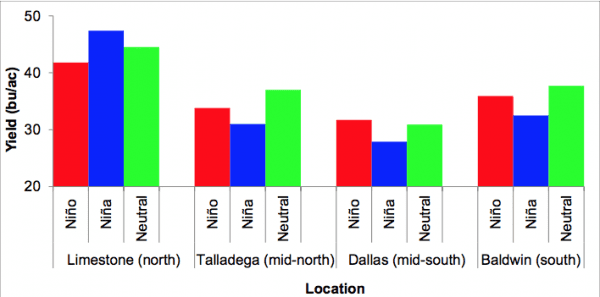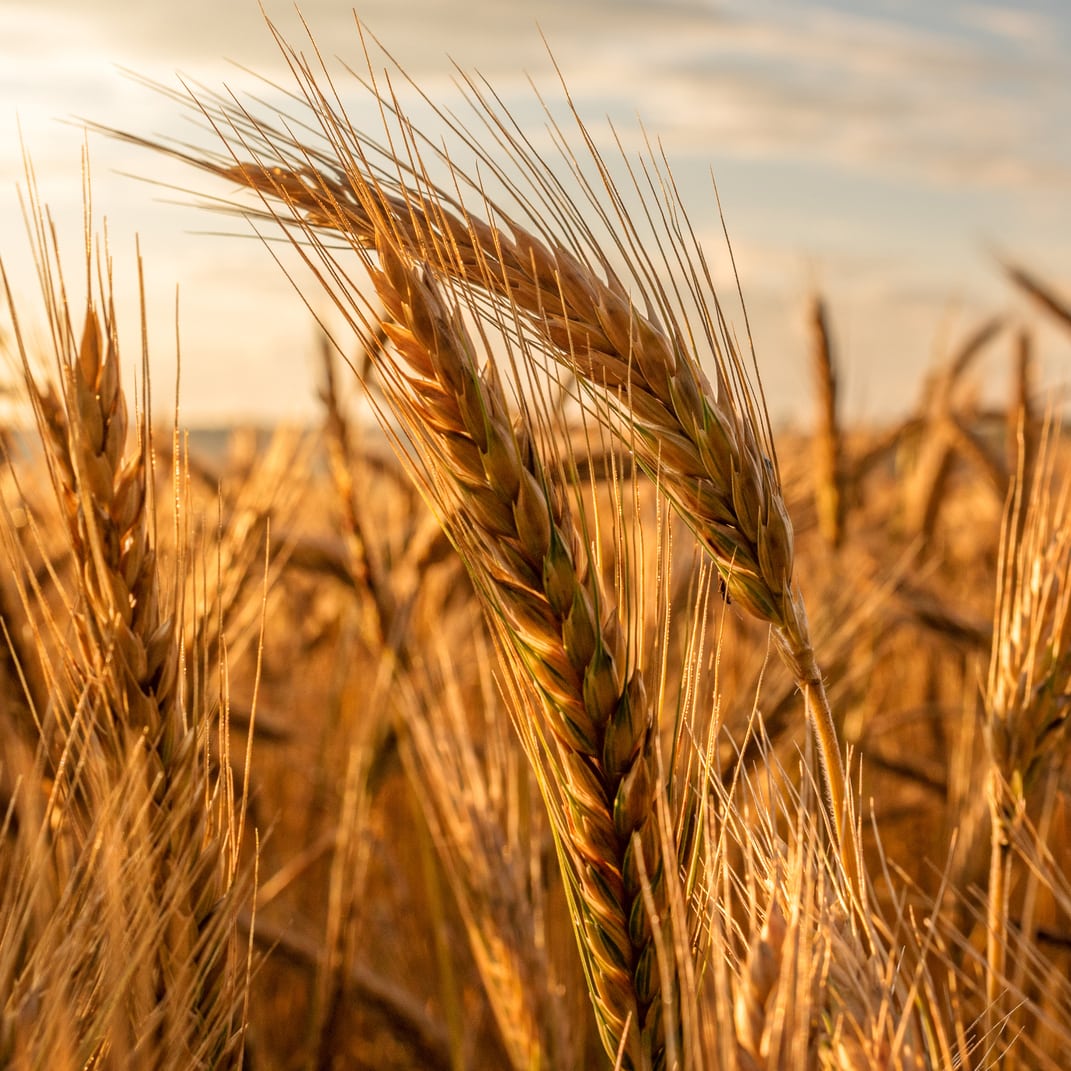Crop Production

The production of soft red winter wheat is mainly concentrated in the northern Alabama (the Northern Valley and the northeastern region of the Appalachian Mountains in Alabama) followed by the southern part (the Coastal Plain and Gulf Coast), although wheat fields are spread out throughout the state. Limestone, Madison, Lauderdale, Morgan, Lawrence, Jackson, DeKalb, Marshall, and Colbert are the leading counties in the northern region, and Baldwin, Escambia, Geneva, Houston, Henry, Dale, Coffee, and Covington are the leading counties in the southern region.
The climate variability is mainly linked to ENSO, which is an oscillation that occurs every 3 to 7 years between warm and cold phases of sea surface temperature in the Equatorial Pacific. The El Niño phase of ENSO results in lower winter temperatures and higher winter-spring rainfall. The La Niña phase of ENSO causes warmer and drier conditions from fall to spring.
Climate forecasting can be a valuable tool in increasing yields and securing a more profitable crop. Why? Because wheat is as susceptible to changes in temperature and precipitation as many other crops, especially in Alabama, where climate varies widely from year to year.
Here is how you can use this climate information to enhance yields and secure higher levels of profitability.
Key Climate Impacts and Management Strategies
Drier/Warmer Winter and Spring
| Impact | Strategy |
|---|---|
| Yield | |
| Late planting results in yield losses. Higher losses for late than early maturity varieties are mainly due to the lack of vernalization | Avoid planting later than the recommended date for your area. |
| Yield losses if grown on sandy loam soils with low water-holding capacity, especially in coastal areas | Reduce the area planted in these areas. |
| Yield losses due to a shorter growing season and grain-filling period, lack of vernalization, and increased leaf senescence | The yield loss is associated mainly with late planting. Plant early maturity varieties. |
| Early planting of early maturity varieties results in lower yields due to accelerated growth and development and spring freeze injury. Late planting of late varieties causes smaller yields due to insufficient vernalization. Long-day photoperiod varieties have low yield and grain quality due to early flowering and short grain-filling period. Late heading results in grain filling under hot and dry conditions, which leads to lower yields. | Plant late maturity varieties first and early maturity varieties last. |
| Insect Pests | |
| Higher likelihood of larger Hessian fly populations because warmer conditions during October?February promotes their reproduction. The infestation is larger on susceptible varieties compared to resistant ones. | Avoid early planting. Plant at the recommended time for your location. Plant Hessian-fly-resistant varieties. Avoid planting wheat after wheat. More intense scouting for Hessian fly is needed. |
| Increased populations of grain aphids | More intense scouting for aphids is needed. |
| Increased populations of grasshoppers | Scout wheat at heading and treat if grasshoppers are clipping heads. |
| Diseases | |
| Increased outbreak of barley yellow dwarf virus due to more aphids | Avoid early planting. Extra scouting is needed for aphids. |
| Reduced risk of rust diseases and glume blotch | Scout at jointing to flag leaf emergence to assess disease risk. |
Wetter/Cooler Winter and Spring
| Impact | Strategy |
|---|---|
| Insect Pests | |
| More occurrences of true armyworm caterpillars and winter grain mites | Additional scouting is needed for these insect pests. |
| Diseases | |
| Increased occurrence of the soilborne wheat mosaic disease in southern areas | Follow crop rotation, use resistant varieties, and plant at the recommended time for your location |
| Increased occurrence of the wheat spindle streak soilborne mosaic disease | Follow crop rotation, use resistant varieties, and plant at the recommended time |
| Increased outbreaks of glume and leaf blotch, rust, black chaff, and take-all diseases | Follow crop rotation, use resistant varieties, plant at the recommended time, scout at jointing through head emergence, and carry out seed dressing. |
| Increased risk of head scab when wetter conditions occur at flowering | Perform deep tillage, use clean seed, use resistant/ tolerant varieties when available, and apply fungicides based on head blight risk (http://www.wheatscab.psu.edu/). |
Drier/Warmer Summer
| Impact | Strategy |
|---|---|
| Insect Pests | |
| More fall armyworms are likely to attack in fall. | Extra scouting is needed for armyworms. |
| More aphids, the vectors of barley yellow dwarf virus, are possible the following wheat season. | Extra scouting is needed for aphids. |
Wetter/Cooler Summer
| Impact | Strategy |
|---|---|
| Insect Pests | |
| Possible increase of Hessian flies due to more available moisture during August?September. The infestation is larger on susceptible varieties compared to resistant ones. | Avoid early planting. Plant at the recommended time. Plant resistant varieties. Avoid planting wheat after wheat. More intense scouting needed. |
Drier/Warmer Fall
| Impact | Strategy |
|---|---|
| Insect Pests | |
| Increased populations of Hessian flies because warmer conditions during this period promotes their reproduction. | As mentioned above |
| Increased populations of aphids | Extra scouting is needed. |
Wetter/Cooler Fall
| Impact | Strategy |
|---|---|
| Insect Pests | |
| Winter grain mites may possibly be worse. | Extra scouting is needed for this insect pest. |
Seasonal Climate Variability Affecting Wheat Production in Alabama
- The ocean-atmospheric phenomenon associated with unusually warm water that occasionally forms across the tropical eastern and central Pacific is referred to as the El Niño
- The La Niña phase is characterized by cooler than average sea surface temperatures across the same region.
- The phenomenon associated with close-to-average sea surface temperature in this region is referred to as the Neutral
- El Niño, La Niña, and Neutral are the three phases of ENSO (El Niño-Southern Oscillation). In Alabama, ENSO affects rainfall and temperature mainly during fall, winter, and spring
- In El Niño phase years, the southern part of Alabama is wetter and cooler than average condition during winter, whereas the northern part is drier and The conditions are just opposite in a La Niña phase year.
- Among the ENSO phases, La Niña results in the highest wheat yields in the northern part of the state, whereas El Niño tends to produce most in the mid-southern part (Figure 1). Of all phases, the neutral phase yields are the largest in the southern and mid-northern parts. La Niña produces more yields than El Niño in the northern part, whereas El Niño produces more yields than La Niña in the central and southern locations.
- Yield losses associated with delayed planting are high in La Niña phase years, moderate in Neutral phase years, and low in El Niño phase
- In a wetter season, the anaerobic condition in soil due to water logging may reduce root growth and result in nitrogen and phosphorus deficiency.
- Temperature and precipitation are key weather variables determining growth, development, and yield of Due to lower temperatures during growing season, El Niño phase years generally result in larger yields. La Niña phase years, in contrast, have smaller yields due to higher temperatures during the season. Higher temperatures lead to shorter growing season, shorter grain-filling period, lack of vernalization, and increased leaf senescence. Higher temperatures in February, however, are beneficial due to an enhancement of early development, following vernalization.

Figure 1. Wheat yield differences among ENSO phases for four locations in Alabama.

